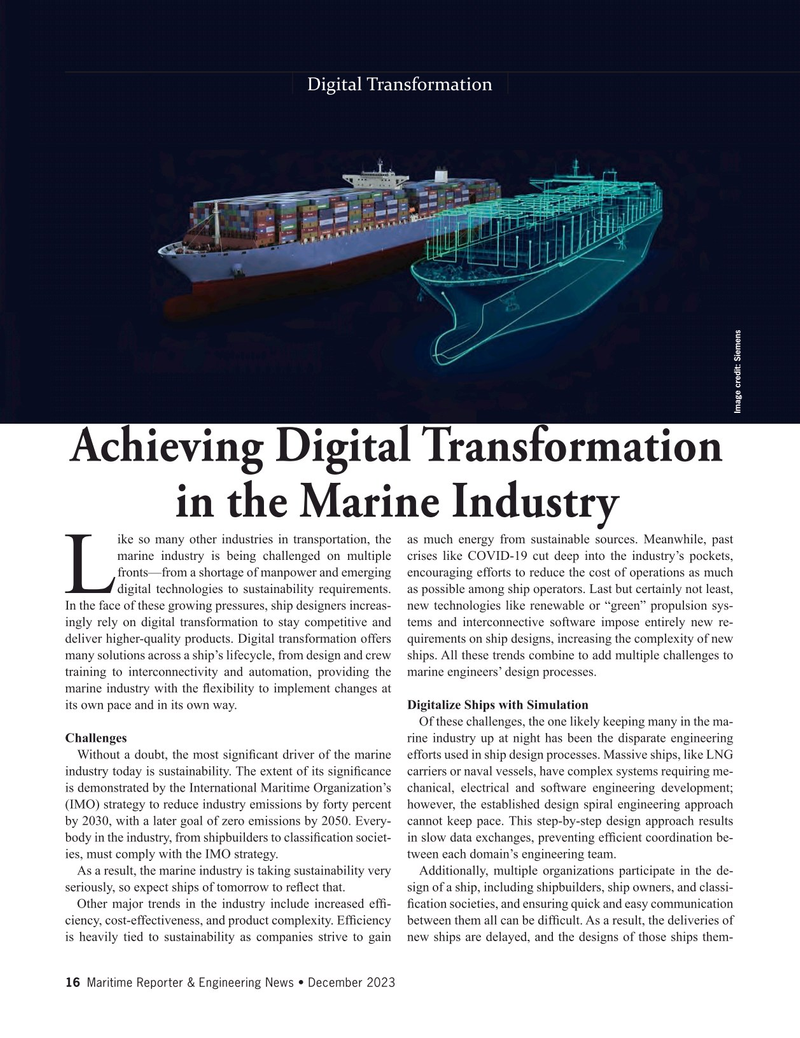
Page 16: of Maritime Reporter Magazine (December 2023)
Great Ships of 2023
Read this page in Pdf, Flash or Html5 edition of December 2023 Maritime Reporter Magazine
Digital Transformation
Image credit: Siemens
Achieving Digital Transformation in the Marine Industry ike so many other industries in transportation, the as much energy from sustainable sources. Meanwhile, past marine industry is being challenged on multiple crises like COVID-19 cut deep into the industry’s pockets, fronts—from a shortage of manpower and emerging encouraging efforts to reduce the cost of operations as much
Ldigital technologies to sustainability requirements. as possible among ship operators. Last but certainly not least,
In the face of these growing pressures, ship designers increas- new technologies like renewable or “green” propulsion sys- ingly rely on digital transformation to stay competitive and tems and interconnective software impose entirely new re- deliver higher-quality products. Digital transformation offers quirements on ship designs, increasing the complexity of new many solutions across a ship’s lifecycle, from design and crew ships. All these trends combine to add multiple challenges to training to interconnectivity and automation, providing the marine engineers’ design processes.
marine industry with the ? exibility to implement changes at its own pace and in its own way. Digitalize Ships with Simulation Of these challenges, the one likely keeping many in the ma-
Challenges rine industry up at night has been the disparate engineering
Without a doubt, the most signi? cant driver of the marine efforts used in ship design processes. Massive ships, like LNG industry today is sustainability. The extent of its signi? cance carriers or naval vessels, have complex systems requiring me- is demonstrated by the International Maritime Organization’s chanical, electrical and software engineering development; (IMO) strategy to reduce industry emissions by forty percent however, the established design spiral engineering approach by 2030, with a later goal of zero emissions by 2050. Every- cannot keep pace. This step-by-step design approach results body in the industry, from shipbuilders to classi? cation societ- in slow data exchanges, preventing ef? cient coordination be- ies, must comply with the IMO strategy. tween each domain’s engineering team.
As a result, the marine industry is taking sustainability very Additionally, multiple organizations participate in the de- seriously, so expect ships of tomorrow to re? ect that. sign of a ship, including shipbuilders, ship owners, and classi-
Other major trends in the industry include increased ef? - ? cation societies, and ensuring quick and easy communication ciency, cost-effectiveness, and product complexity. Ef? ciency between them all can be dif? cult. As a result, the deliveries of is heavily tied to sustainability as companies strive to gain new ships are delayed, and the designs of those ships them- 16 Maritime Reporter & Engineering News • December 2023
MR #12 (1-17).indd 16 12/5/2023 9:58:36 AM

 15
15

 17
17
